Ijraset Journal For Research in Applied Science and Engineering Technology
- Home / Ijraset
- On This Page
- Abstract
- Introduction
- Conclusion
- References
- Copyright
Synthesis and Characterization of 4-Nitropheny Maleimide and Copolymerized with Acrylonitrile and Acrylamide
Authors: Suresh Kumar Meena, Sanjeet Singh
DOI Link: https://doi.org/10.22214/ijraset.2023.48793
Certificate: View Certificate
Abstract
In this article we are prepared heat resistant polymer containing N-(4-Nitro phenyl) maleimide (PNPMI) and Acrylonitile copolymerization under the identical conditions in DMF and THF solvent. The characteristics of the copolymer were analyzed by Fourier transform infrared spectroscopy, nuclear magnetic resonance spectroscopy, gelpermeation chromatography, and elemental analysis. The thermal stability and degradation mechanism of the copolymer were investigated by Thermogravemetric analysis. Free radical initiator using as an AIBN and BPO in Polymerization reaction , Percentage yield and different solvent system applied and calculated percentage yield. Percentage nitrogen, carbon, and hydrogen content calculate in polymers. The radical polymerization find out by the Polydispersity index. Shape of the polymer in given solution were determined by using range in between according to PDI index. Polymerization process observed by the Polydispersity index. Intrinsic viscosity determined by the using Ubbehold viscometer .Excellent composition structure and Solubility of the Homopolymer and copolymer were determined in different solvent.
Introduction
I. INTRODUCTION
High-performance polymer matrix composites, particularly for aerospace applications, are designed to withstand high thermal and aerodynamic stresses. Among the diverse thermoset resins, bismaleimide resin and Phenylmaleimide polymer stands out as a class of high-performance addition-curable polyimide resin having excellent thermal, physical, and thermo mechanical properties. Thermal behavior of acrylonitrile copolymers is highly depend on the method of polymerization, chemical nature of comonomer and its content. Properties like glass transition temperature , melting and crystallization is affected by the change in crystallinity and perfection. Gupta and coworkers [1] investigated the effect of 2-hydroxy ethyl methacrylate, methacrylonitrile and methylacrylate on crystallinity and crystalline perfection using X-ray and dielectric measurements. The determination of the reactivity ratio has been the major focus of studies described in the open literature for this copolymerization system .[2-11] .In continuation our previous published paper of 2-Nitro phenylmaleimide,3-Nitro Phenylmaleimide and copolymers with various amounts of methylacrylate and methylmathacrylate in copolymer and their comparative study investigated [12]. Aromatic polyimides are one of the most important classes of high performance polymers. Due to their thermal, electrical and high-temperature mechanical properties, aromatic polyimides have found many applications as high temperature insulators, coatings, adhesives and matrices for high-performance composites [13] In present article we are synthesis of newly maleimide monomer of 4-Nitrophenylmaleimide and copolymerized with Acrylonitrile and characterized by the 1H-NMR,FTIR and Thermal analysis by the Thermogravemetric analysis.
II. EXPERIMENTAL
A. Materials
Maleicanhydride were recrystallized from acetone. Methylmethacrylate (CDH) was shaken two to three times with 5% NaOH to eliminate hydroquinone inhibitor, dried over anhydrous CaCl2 for 6 hours and distilled [14]. The head and tail fractions were discarded. AIBN (2,2_-azobis–isobutironitrile (spectorchem.)) was recrystallized twice from methanol prior to use. BPO (benzoyl peroxide CDH) was used as received. THF was purified by distillation after being refluxed for 2 h in the presence of sodium. Dioxane and DMSO were used after distillation. DMF and methanol used in the present work were of analytical grade and were used as received.
Measurements
1H-NMR spectra of monomer and polymer samples were taken in DMSO-d6 on a Bruker DPX-200/DPX-300 spectrometer at 200/300 MHz. The internal reference used was TMS. FT-IR spectra of the monomer and polymer sample were recorded on a Shimadzu 8201 PC (4000-400 cm-1) FT-IR spectrometer, using KBr pellet technique. The viscosity measurements were carried out in DMF at 30±0.2 °C, using an Ubbelohde suspended level viscometer. Elemental analysis was made on Carlo Erba Model NA 500 series analyzer. The thermograms in air were obtained on a Mettler TA-3000 system, at a heating rate of 10 °C/min
B. Methods
Preparation of N-(4-Nitorphenyl) maieimide (PNPMI): Nitroaniline (13.8 gm for 0.1mol) and 9.8 gm maleic anhydride were taken in 30 ml DMF. The reaction mixture was stirred for three hours at 25°C. The reaction mixture was poured in crushed ice. Yellow solid precipitate was obtained, then filtered and dried under vacuum. It was recrystallized from methanol to obtained pure N-(4-Nitrophenyl) maleamic acid. Yield was 70%, m.p. 145°C.
N-(4-Nitrophenyl) Maleimide: Cyclodehydration of the 4-Nitromaleamic acid, this solution treated with conc. H2SO4 and P2O5 and stirred for three hours at 65°C. Then the solution poured in crushed ice or cooled water, obtained to yellow solid precipitate filtered and washed with water and dried.N-(4-Nitrophenyl) maleimide was recrystallized from ethyl alcohol solvent. The yield was 65%, m.p. 120°C.
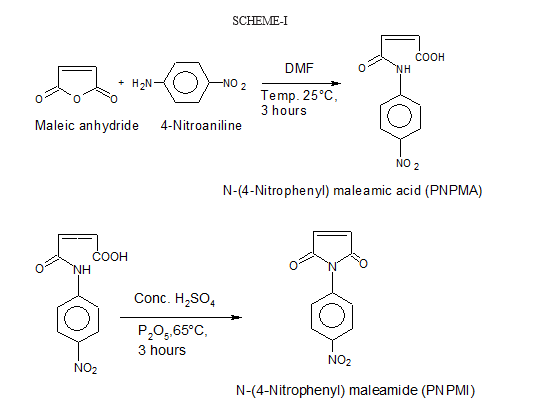
C. Homopolymerization of N-(4-Nitrophenyl) maleimide (HPNPMI)
4-Nitrophenylmaleimide (2.18 gm, 0.01 mol) were taken in 30 ml THF solvent in round bottom flask with reflux condenser. Free radical 20 mg AIBN was added and the reaction mixture was refluxed on heating mental at 65°C for 12, 24, 36 and 48 hours. Product was occurred 32.33% for 24 hours. Prepared polymer was separated in excess amount of methanol water mixture. It was dried under vacuum at 55°C then kept under dedicator free from moisture.
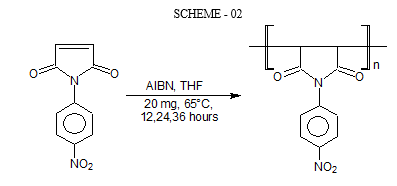
D. Copolymerization of N-(4-Nitrophenyl) maleimide with Acrylonitrile (PNPMCAN)
Equal amount of 4-Nitrophenylmaleimide and Acrylonitrile in 30 ml THF solvent were taken in a round bottom flask. The reaction was carried out at 65°C for 12, 24 ,36 hours. Copolymer samples were isolated in water containing 20 % methanol. The copolymer were purified by first dissolving in THF and then, reprecipitating in excess quantity of methanol water mixture. The precipitated copolymers were washed with methanol several times and dried at 60°C under vacuum.

E. Copolymerization of N-(4-Nitrophenyl) maleimide with Acrylamide (PNPMCAA)
Equal amount of 4-Nitrophenylmaleimide and Acrylamide in 30 ml THF solvent were taken in a round bottom flask. The reaction was carried out at 65°C for 12, 24 ,36 hours. Copolymer samples were isolated in water containing 20 % methanol. The copolymer were purified by first dissolving in THF and then, reprecipitating in excess quantity of methanol water mixture. The precipitated copolymers were washed with methanol several times and dried at 60°C under vacuum.

III. RESULTS AND DISCUSSION
A. PNPMI
FT-IR spectra (Fig.1, in cm–1) 3091.3, 2980.8 (aromatic and alkene C-H stretch), 1797 and 1708 ( C=O) [15,16]. 1634(CH=CH), 1564 1456 (C=C, aromatic) [17,18].1335,1504 (symmetric and asymmetric stretch of –NO2) [19]. 967 (CH=CH) [20]. 856(1,4 disubstituted benzene) these are consistent with the structure of PNPMI. 1H-NMR spectra (Fig.2, 400 MHz TMS, DMSO-d6, d, ppm) of PNPMI shows two methine (CH=CH) protons at d 6.82 (s) ppm; two aromatic protons (o-group in phenyl ring) at d7.13-7.15 (d) ppm; two aromatic proton (m-group in phenyl ring) at d7.63-7.64 (d) ppm .
B. HPNPMI
In Fig. 3, for HPNPMI, 3088 (C-H aromatic), 2981 (C-H stretch alkene), 1778, ( C=O group) 1614, 1651, 1563, 1444, 1596 (C=C stretch aromatic), 1504, 1331 (symmetric and asymmetric, Ar-NO2 group), 1255 (asymmetric C-O-C stretch), 1110, 1168 (symmetric C-O-C stretch), 856 (1,4 disubstituted benzene) and 690, 605 (out of plane aromatic ring C=C bend) are consistent with the structure of HPNPMI. In Fig.4, the 1H–NMR spectrum of HPNPMI is observed at d 7.50–8.08 (d). 2H in –CH–CH– group have appeared at 3.5–4.0 ppm. 1H–NMR of PPNPMI monomer shows chemical shift d at 6.82 (s) ppm characteristic of CH=CH group. The disappearance of this in polymer PPNPMI shows that the radical polymerization proceed through the double bond [ 21-23].
C. PNPMCAN
In fig.5, 3937.3 (Aromatic,C-H),3278 (CH=CH), 1718, 1775 (C=O), 1559 (-NO2 group) 1461.9 (C-H band, –CH2), 1394,1301 ( C-N, Stretching of maleimide), 1174 (C-O-C), 1560 (-NO2), 832 (1,2-disubstituted benzene) and 774.3 cm–1 (out of plane C-H band of benzene ring), and 668 (out of plane (aromatic ring C=C band). 1H-NMR of PNPMCAN, In Fig.6, d values from 7.5 to 8.1 due to present of phenyl ring and a signal of showing d at 4.0 present of AN, d values obtained in 2.8 to 3.6 ppm, polymerization precede via single bond.
D. PNPMCAA
In fig.7, 2931 (Aromatic,C-H),3092 (CH=CH), 1718, 1709 (C=O), 1559 (-NO2 group) 1484 (C-H band, –CH2), 1384,1301 ( C-N, Stretching of maleimide), 1188 (C-O-C), 1531 (-NO2), 890 (1,2-disubstituted benzene) and 774.3 cm–1 (out of plane C-H band of benzene ring), and 672 (aromatic ring C=C band). 1H-NMR of PNPMCAA, In Fig.8, d values from 7.5 to 8.1 due to present of phenyl ring and a signal of showing d at 4.0 present of AN, d values obtained in 2.8 to 3.7 ppm.
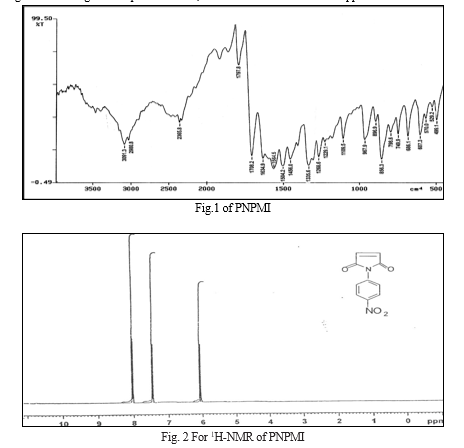
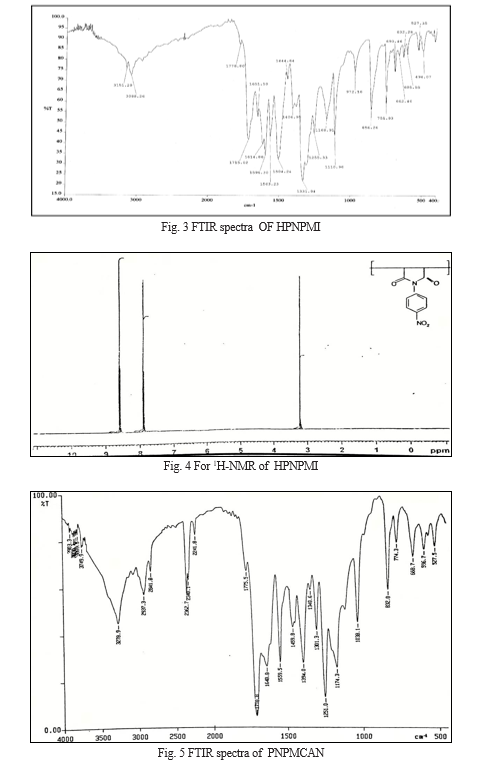
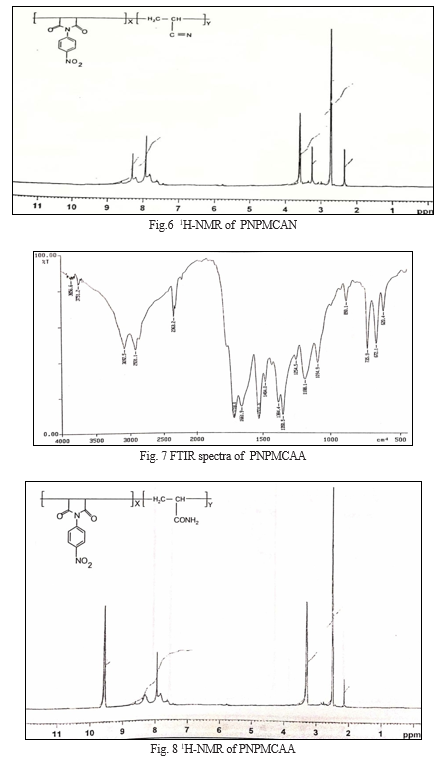
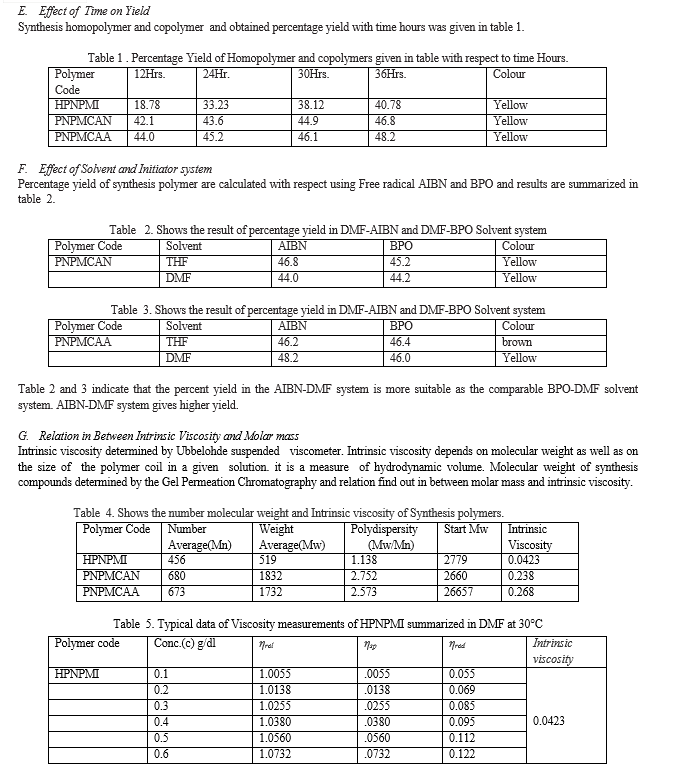
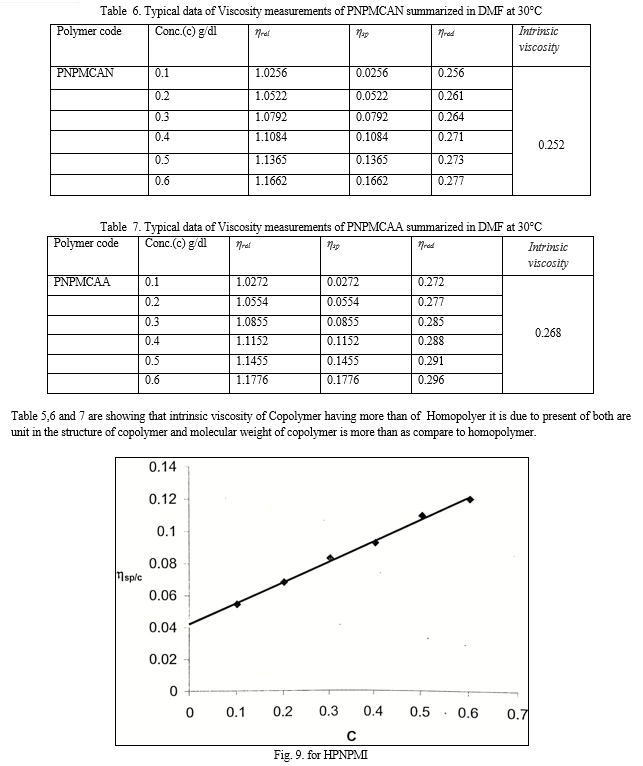
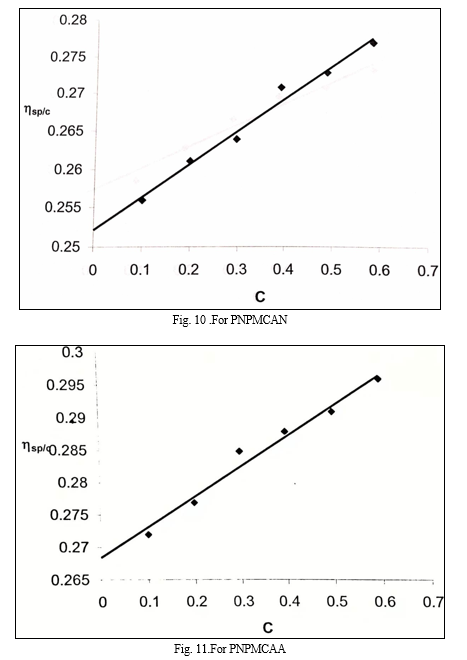
H. Solubility Behavior of Polymers
Polymers were finely grounded and polymer powder which was placed into test tube and two to three ml solvent was added and stirred at 30C. Solvents were taken as follows THF, DMF, DMSO, Benzene. Methylacetate,, 1,4Dioxane, Xylene, dichloromethane, 2Butanol,cyclohexanon,water,methanol and carbon tetrachloride. Solubility of any polymeric materials depends upon the composition like as polymer texture, temperature, pressure etc. Solubility of homopolymer is less than copolymer while always not same condition is not found in regular manner. Result of Solubility is summarized in table. 8
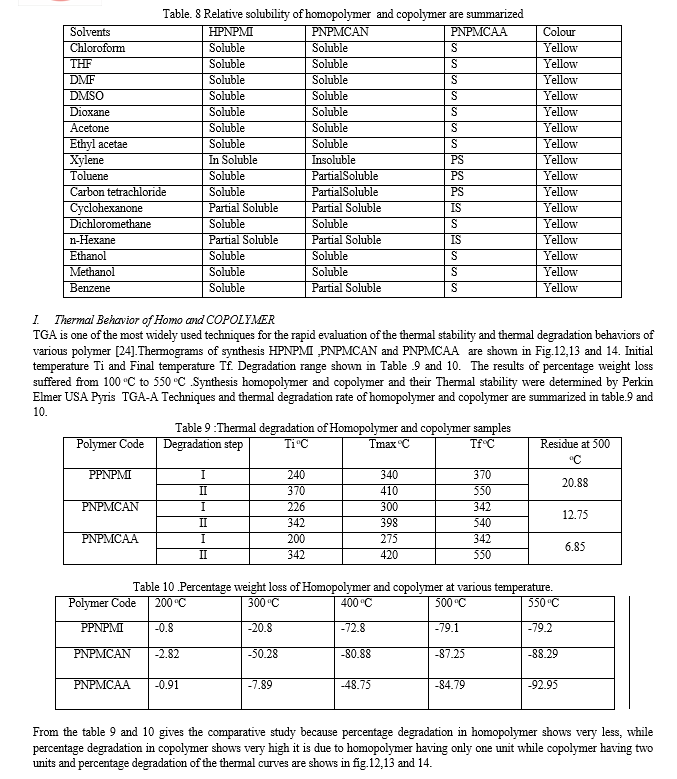
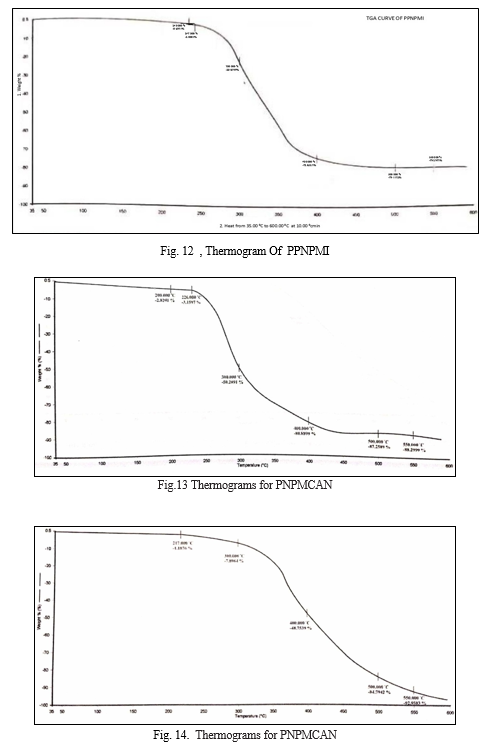
IV. ACKNOWLEDGEMENT
We are thankful to CDRI Luck now and SICART Vallabh-Vidhyanagar for analysis work. Authors Shiv NarayanPaliwal and Suresh Meena is thankful to UGC (RGNSF), DST FIST ,New Delhi or financial assistance.
Conclusion
Synthesis homopolymer and copolymer shows the excellent solubility in THF,DMF ,DMSO, Chloroform .Ethyl acetate and solubility of any polymeric materials depends on the composition like as texture and length ,molecular weight, Intrinsic viscosity. It is observed that polymerization reactions completed via radical polymerization this is approved by the Polydispersity index. Copolymer shows highly molecular weight more than of homopolymer it is due to copolymer having both are unit. Weight average and number average molecular weight determined by the Gel permeation chromatography. Polymers exhibit highly thermal stability due to present of imide ring and Homopolymer shows highly thermal stability than copolymers because homopolymer contain only single unit in their backbones.
References
[1] P. Bajaj, T.V. Sreekumar1 , K. Sen., Thermal behaviour of acrylonitrile copolymers having methacrylic and itaconic acid comonomers, Polymer .42,1707–1718.2001 [2] S. I. Kuchanov, \"Modern aspects of quantitative theory of free-radical copolymerization.\" Free Radical Copolimerization Dispersions Glassy State Relaxation (2005): 1-101. [3] R. Z. Greenley, Recalculation of some reactivity ratios. Journal of Macromolecular Science: Part A-Chemistry, 14(4), 445-515.1980 [4] A. Feherværi, T., Foldes-Berezsnich and Tüdöss, F. Kinetics of Free Radical Copolymerization. V. Copolymerization of Ethyl Acrylate with Styrene. Composition of Copolymers. Journal of Macromolecular Science—Chemistry, 18(3), 337-346. 1982 [5] A. Cunliffe, Synthetic Macromolecules. Nuclear Magnetic Resonance: Volume 15, 216.2017 [6] S. Djekhaba & J. Guillot, Batch emulsion copolymers styrene with ethyl acrylate: microstructure and glass transition temperature. European polymer journal, 26(9), 1017-1025.1990 [7] S. Djekhaba, C. Graillat, Guillot, Copolymérisation en émulsion acrylate d\'éthyle-styrène—1. Étude cinétique en réacteur fermé (batch). European polymer journal, 24(2), 109-116.1988 [8] A. S. Brar, Microstructure determination of styrene/ethyl acrylate copolymers by NMR spectroscopy and its correlation with glass transition temperature. Die Makromolekulare Chemie: Macromolecular Chemistry and Physics, 194(6), 1707-1720.1993 [9] C. J. Knill, & J. F. Kennedy, Polymer handbook -J. Brandrup, EH Immergut, EA Grulke (Eds.); Wiley, New York, Carbohydrate Polymers, 3(46), 295.2001 [10] N.T.McManus & A.Penlidis, A kinetic investigation of styrene/ethyl acrylate copolymerization. Journal of Polymer Science Part A: Polymer Chemistry, 34(2), 237-248. (1996) [11] N. Sahloul & A. Penlidis, High temperature copolymerization of styrene/ethyl acrylate: Reactivity ratio estimation in bulk and solution. Advances in Polymer Technology: Journal of the Polymer Processing Institute, 23(3), 186-195. 2004 [12] S .K. Meena, A Comparative Study of N-(O-Nitrophenyl) Maleimide Polymer and N-(M-Nitro Phenyl) Maleimide and Effect of Electron Withdrawing Group on Thermal Stability ,Human Journals .,Vol.:23, Issue:2, December 2022 [13] S .K. Meena, Recent Study of Some New Maleimide Copolymers and Their Electrolyte Study in Solvent., International Journal of Engineering Research & Technology ., Vol. 11 Issue 12, December 2022. [14] B.L.Hiran. S. K.Meena , B. S. Meena. M.Meena, Thermal Study and Characterization of New Synthesis N-Benzylmaleimide and N- Phynyl Maleimide Polymers, International Journal of Engineering Research & Technology, 8 : 07, 2019 [15] J. A. Riddick. W. B. Bunger & T. K. Sakano, Organic solvents: physical properties and methods of purification.1986 [16] J.Chaudhary & R.Chaudhary, Copolymers Of Ma/Ea/Ba With N-Substituted Maleimide: Synthesis, Characterization And Effect On The Thermal Properties, International Journal Of Engineering Sciences & Research Technology. 5(8): August, 2016 [17] P. Beekman. A. .Enciso-Martinez. S. P. Pujari, L. W. Terstappen Zuilhof. H, Organosilicon uptake by biological membranes. Communications Biology, 4(1), 1-8.2021 [18] M. H. Patel & S. B. Oswal, Synthesis and Characterization of Homo-and Copolymers of N-4-Azodiphenyl Maleimide with Methyl Methacrylate and Styrene. International Journal of Polymeric Materials, 60(8), 542-561.2011 [19] T. Otsu, T. Yasuhara, & A. Matsumoto,. Synthesis, characterization, and application of poly [substituted methylene] s. Journal of Macromolecular Science—Chemistry, 25(5-7), 537-554.1988 [20] A. Matsumoto, T. Kubota, &T. Otsu, Radical polymerization of N-(alkyl-substituted phenyl) maleimides: synthesis of thermally stable polymers soluble in nonpolar solvents. Macromolecules, 23(21), 4508-4513.1990 [21] T.Otsu, T. Yasuhara, & A. Matsumoto, Synthesis, characterization, and application of poly [substituted methylene] s. Journal of Macromolecular Science—Chemistry, 25(5-7), 537-554.1988 [22] A. Matsumoto,T. Kubot, &T. Otsu, Radical polymerization of N-(alkyl-substituted phenyl) maleimides: synthesis of thermally stable polymers soluble in nonpolar solvents. Macromolecules, 23(21), 4508-4513.1990 [23] R.M.Silverstain, G.C.Bassler and T.C. Morril , Spectrometric Identification of Organic Compounds, 4th Edn. John Wiley and Sons. Inc. New York .1991 [24] J.Saihua,H. Yuan , G. Zhou, D.Yangyang , Enhanced Thermal Properties and Flame Retardancy of a Novel Transparent Poly(methyl methacrylate)-Based Hybrid Prepared by the Sol?Gel Method,. Ind. Eng. Chem. Res. 2012, 51, 9447?9455
Copyright
Copyright © 2023 Suresh Kumar Meena, Sanjeet Singh. This is an open access article distributed under the Creative Commons Attribution License, which permits unrestricted use, distribution, and reproduction in any medium, provided the original work is properly cited.

Download Paper
Paper Id : IJRASET48793
Publish Date : 2023-01-22
ISSN : 2321-9653
Publisher Name : IJRASET
DOI Link : Click Here
 Submit Paper Online
Submit Paper Online

